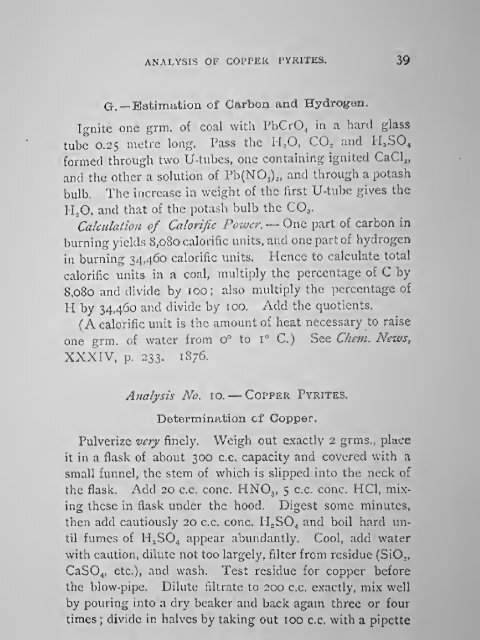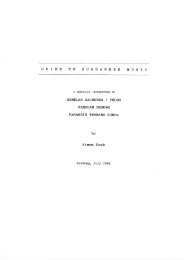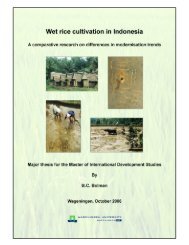The Students' Guide in Quantitative Analysis - Free Ebooks Library
The Students' Guide in Quantitative Analysis - Free Ebooks Library
The Students' Guide in Quantitative Analysis - Free Ebooks Library
You also want an ePaper? Increase the reach of your titles
YUMPU automatically turns print PDFs into web optimized ePapers that Google loves.
ANALYSIS OF COPPER PYRITES. 39<br />
G, — Estimation of Carbon and Hydrogen.<br />
Ignite one grm. of coal with PbCrO^ <strong>in</strong> a hard glass<br />
tube 0.25 metre lon^'. Pass the IIjO, CO, and MaSO^<br />
formed through two U-tubes, one conta<strong>in</strong><strong>in</strong>g ignited CaC^,<br />
and the other a solution of Pb(N03)„ and through a potash<br />
bulb, <strong>The</strong> <strong>in</strong>crease <strong>in</strong> weight of the first U-tube gives the<br />
IIjO, and that of the potash bulb the COj,<br />
Calculation of Calorific Power. — One part of carbon <strong>in</strong><br />
burn<strong>in</strong>g yields S.oSo calorific units, and one part of hydrogen<br />
<strong>in</strong> burn<strong>in</strong>g 34,460 calorific units. Hence to calculate total<br />
calorific units <strong>in</strong> a coal, multiply the percentage of C by<br />
8,080 and divide by 100; also multiply the percentage of<br />
H by 34,460 and divide by ico. Add the quotients.<br />
(A calorific unit is the amount of heat necessary to raise<br />
one grm. of water from 0° to i" C.) See Chem. News,<br />
XXX [V. p. 233. 1876.<br />
<strong>Analysis</strong> No. 10. — Copper Pyrites.<br />
Determ<strong>in</strong>ation cf Copper.<br />
Pulverize very f<strong>in</strong>ely. Weigh out exactly 2 grms., place<br />
it <strong>in</strong> a flask of about 300 c.c. capacity and covered with a<br />
small funnel, the stem of which is slipped <strong>in</strong>to the neck of<br />
the flask. Add 20 c.c. cone. HNO3, 5 c.c. cone. HCl, mix-<br />
<strong>in</strong>g these <strong>in</strong> flask under the hood. Digest some m<strong>in</strong>utes,<br />
then add cautiously 20 c.c. cone. H;SO^ and boil hard un-<br />
til fumes of HjSO^ appear abundantly. Cool, add water<br />
with caution, dilute not too largely, filter from residue {SiO,,<br />
CaSO,, etc.), and wash. Test residue for copper before<br />
the blow-pipe. Dilute filtrate to 200 c.c. exactly, mix well<br />
by pour<strong>in</strong>g <strong>in</strong>to a dry beaker and back agam three or four<br />
times ;<br />
divide <strong>in</strong> halves by tak<strong>in</strong>g out too c.c. with a pipette








